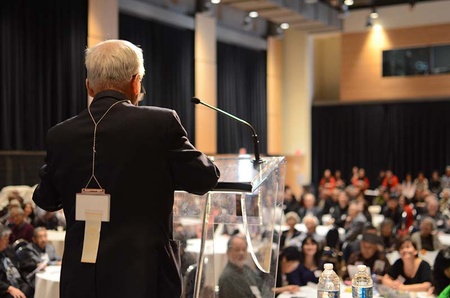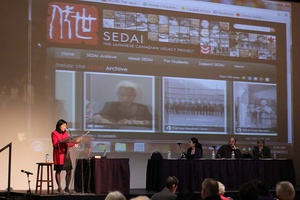Read Part 1 >>
One hint as to the prevailing spirit was that during the day several different people spoke of working in Jewish firms, which were the only ones that did not practice discrimination, or compared their experience with Jewish friends and classmates (Frank Moritsugu spoke of being hired in 1952 by McLean’s and being welcomed by the staff. Soon after, a reporter who had been on assignment returned, ushered Frank into his office, shut the door, and then said, “As the first Jew in this building, let me welcome the first Japanese.” The man, Sid Katz, had broken the longstanding no-Jews policy of the Maclean-Hunter syndicate shortly before).
Two other things struck me during the storytelling sessions. One was how incredibly busy people were, having to hustle to survive and make something of themselves. (One Nisei said that his parents instructed him that his priority A was education, priority B was education, priority C was education…) This did not leave much time for political activity, or in some cases even socializing. One storyteller recalled that playing high school basketball was out of the question for him, because it would not help him get into a good college.
The other striking thing to me was how often people continued to live with or near their folks and connect with them. Today we have the “boomerang” generation, where kids who go off to university return home afterwards to live with their folks, and we think of it as a social crisis. For the postwar Nisei, such a thing was normal if not predominant.
Between the first and second storytelling sessions, we had the pleasure of hearing a lecture by Frank Moritsugu, a veteran journalist whose career in both ethnic Japanese and mainstream Canadian media has extended over more than 70 years. Frank was not only witty and entertaining, but he enunciated with force what I agree is a central theme of the conference—that postwar Japanese Canadians, by their various efforts, pushed the doors of opportunity open for other minority Canadians to be able to be and do anything they wished. (The younger generations in North America now can probably scarcely believe that there ever was such a thing as laws against interrracial marriage, but several people told me of having to face tensions with their parents over their non-Japanese spouses.)

Gathering of attendees in Kobayashi Hall for a crash course seminar on the history of Japanese Canadians during the post war years given by Frank Moritsugu, WWII Japanese Canadian veteran. (Courtesy of the Japanese Canadian Cultural Centre)
Following Frank’s presentation, lunch was served. It was made up of bento boxes. I thought this a very nice idea, as it gave us time to socialize informally. I had the pleasure of lunching at a table with a group of older Japanese Canadians. Conversely, after the last storytelling session, the conferencegoers regrouped for dinner. Before the food was served, the conference Organizing Committee played an impressive video of statements from younger Japanese Canadians about the importance of hearing stories from their elders. I thought the video was very well made and fitting.
Then a remarkable thing happened at dinner. I had expected that the food would be inedible (they do not call banquet speaking circles “the rubber chicken circuit” for nothing!) and had even scheduled an outside meal for after the conference. However, the buffet at the conference violated all known rules of banquet conference catering—it was delicious Japanese food, plus a tasty prime rib with horseradish (I asked for the hakujin wasabi), plus green tea and dessert.

Conference Chair and Sedai Project Chair Lorene Nagata providing all attendees with a walkthrough of the Sedai Project website, where all Conference videos will be available. Currently videos from the 2010 JCEC War Years Conference are available to be viewed by the public. (Courtesy of the Japanese Canadian Cultural Centre)
The following morning the conference reconvened, and there were statements by Lorene Nagata, the conference organizer, who gave a kind of tour of the online historical website Sedai, and (in absentia) by JCCC president Gary Kawaguchi. There was also a chance for audience members to engage in discussion about the conference with input from a panel formed of Lorene Nagata, Elizabeth Fujita of Sedai, longtime activist Peter Wakayama, and me. I was also asked to do a wrapup and to speak briefly on how I thought people could build on the conference.
I expressed two interrrelated thoughts. One was that it is important to understand further the postwar community life of Japanese Canadians. To hear the presentations at the conference, one would think that Japanese Canadians had little or no outside life. Yet, while people were certainly busy in their individual lives, the surviving newspaper and organizational record reflects a cornucopia of group social and political activities—community picnics, church groups, fundraisers for Japan, and formation of local chapters of the National Japanese Canadian Citizens Association.
Secondly, the conference convinced me that it would be particularly valuable to start conversations with Sansei about their own postwar experience. Sansei grew up in the shadow of a family wartime experience that was not theirs, but which hung over them. They can teach us about being young in the postwar years, trying to fit in, dealing with entrenched expectations, and having to go through identity issues. Because we will need to speak soon about the 1970s and the amazing cultural flowering—the Powell St. Festival in Vancouver, the founding of the mulicultural magazine Rikka in Toronto, and the start of the redress movement nationwide—we will need to get into the background of the Sansei and discuss how they came of age.

Sharing in the history across generations: clockwise from top left, Pollie Nishino, nisei, and grandmother to yonseis Kristin Kobayashi, Warren Jung, and Aaron Marubashi, with their grandfather Tak Nishino. (Courtesy of the Japanese Canadian Cultural Centre)
© 2013 Greg Robinson





